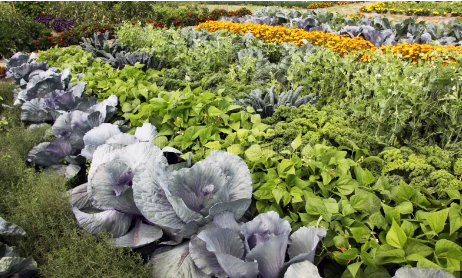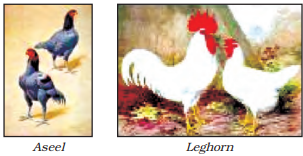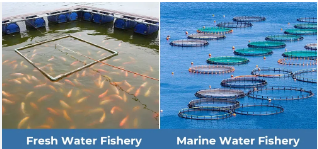Notes For All Chapters Science Class 9
1. Why Do We Need to Improve Food Resources?
- All living things need food to grow and stay healthy.
- Our food gives us carbohydrates, proteins, fats, vitamins, and minerals.
- We get food mainly from plants (agriculture) and animals (animal husbandry).
- India’s population is very large and still growing — so we need more food every year.
- But most of our land is already being used for farming, so instead of increasing land area, we must increase crop yield (produce more food from the same land).
Past Successes:
- Green Revolution: Increased production of grains like wheat and rice.
- White Revolution: Increased milk production.
Problem:
These revolutions used a lot of natural resources. If not managed properly, it can harm the environment.
So, we need sustainable farming — producing more food without harming nature.
2. Improvement in Crop Yields
We can increase crop yield in three main ways:
- Crop Variety Improvement
- Crop Production Improvement
- Crop Protection Management
Types of Crops:
| Crop Type | Examples | What We Get |
|---|---|---|
| Cereals | Wheat, Rice, Maize | Carbohydrates (energy) |
| Pulses | Gram, Pea, Moong, Urad | Proteins |
| Oilseeds | Mustard, Groundnut, Soyabean | Fats |
| Fruits & Vegetables | Many types | Vitamins and Minerals |
| Fodder Crops | Berseem, Oats | Food for animals |
Crop Seasons
| Season | Months | Examples |
|---|---|---|
| Kharif (Rainy Season) | June-October | Paddy, Maize, Soyabean, Cotton |
| Rabi (Winter Season) | November-April | Wheat, Gram, Peas, Mustard |
2.1 Crop Variety Improvement
To get better crops, scientists develop new varieties by improving existing ones.
Methods:
- 1. Hybridisation:
- Crossing two different plants to get a new plant with good qualities.
- Example: One parent gives disease resistance, the other gives high yield.
- 2. Genetic Modification (GM):
- Changing plant genes to add useful traits (like pest resistance).
Desirable Qualities of Improved Varieties:
- High yield – produce more per acre.
- Good quality – better taste, nutrition, or storage.
- Disease and stress resistance – can survive drought, heat, etc.
- Short maturity period – grows fast, allows more crops per year.
- Wider adaptability – grows in different climates.
- Agronomic traits – tall plants for fodder, dwarf for grains.
2.2 Crop Production Management
Farmers use different levels of inputs depending on their money and resources:
- No-cost farming: Simple methods, low yield.
- Low-cost farming: Some fertilizers and irrigation.
- High-cost farming: Advanced seeds, machines, irrigation, and fertilizers.
(i) Nutrient Management
Plants need 17 nutrients to grow properly.
| Source | Nutrients |
|---|---|
| Air | Carbon (C), Oxygen (O) |
| Water | Hydrogen (H), Oxygen (O) |
| Soil | Macronutrients: Nitrogen (N), Phosphorus (P), Potassium (K), Calcium (Ca), Magnesium (Mg), Sulphur (S) Micronutrients: Iron (Fe), Manganese (Mn), Boron (B), Zinc (Zn), Copper (Cu), Molybdenum (Mo), Chlorine (Cl) |
If any of these nutrients are missing, plants grow weak or diseased.
Manure
- Made by decomposing animal waste and plant remains.
- Adds organic matter and nutrients to soil.
- Improves soil structure and water-holding capacity.
Types:
- Compost / Vermicompost: Using waste and earthworms to make rich manure.
- Green Manure: Growing plants like sun hemp and ploughing them into soil.
Fertilizers
- Chemical substances that provide nutrients like Nitrogen, Phosphorus, and Potassium.
- They give quick results and help in high yield.
- But excessive use can pollute water and reduce soil fertility.
Best Practice: Use both manure and fertilizers together.
Organic Farming
Farming without chemicals.
Uses:
- Organic manure & compost
- Biofertilizers (microorganisms that add nutrients)
- Natural pest control (neem, turmeric)
- Mixed cropping & crop rotation
Helps protect the environment and soil health.
(ii) Irrigation
Water is essential for crops.
If rain fails, irrigation helps.
Irrigation Systems:
- Wells: Dug wells and tube wells (use pumps).
- Canals: Bring water from rivers and dams.
- River Lift System: Draws water directly from rivers.
- Tanks: Small ponds that collect rainwater.
New Methods:
- Rainwater harvesting
- Watershed management (building check dams to increase groundwater)
(iii) Cropping Patterns
1. Mixed Cropping:
- Two or more crops together (wheat + gram).
- Reduces risk — if one fails, the other gives yield.
2. Intercropping:
- Crops in alternate rows (eg – soyabean + maize).
- Efficient use of nutrients and reduces pest spread.
3. Crop Rotation:
- Growing different crops one after another (e.g., rice → wheat → pulses).
- Maintains soil fertility.
2.3 Crop Protection Management
Threats to crops:
- Weeds: Unwanted plants (e.g., Parthenium).
- Pests: Insects that eat crops or suck sap.
- Diseases: Caused by bacteria, fungi, and viruses.
Control Methods:
- Chemical: Spraying pesticides, herbicides, fungicides (use carefully).
- Mechanical: Removing weeds manually.
- Preventive:
- Use healthy seeds
- Crop rotation and intercropping
- Use resistant crop varieties
- Summer ploughing (destroys pests)
Storage of Grains
Even after harvest, grains can get spoiled by:
- Biotic factors: Insects, rats, fungi, bacteria
- Abiotic factors: Moisture, heat
Prevention:
- Clean and dry grains properly.
- Fumigate with pest-killing chemicals.
- Store in proper warehouses.
3. Animal Husbandry
Meaning: Scientific care and management of farm animals.
Includes feeding, breeding, and disease control.
Animals: Cattle, poultry, fish, goats, sheep, bees
3.1 Cattle Farming
Purpose:
- Milch animals: Produce milk (e.g., cows, buffaloes)
- Draught animals: Used for work (ploughing, carrying loads)
Improvement:
- Cross-breeding Indian and foreign breeds for better milk and disease resistance.
- Indian breeds: Red Sindhi, Sahiwal
- Exotic breeds: Jersey, Brown Swiss
Care:
- Clean, dry, ventilated shelters
- Balanced diet: roughage + concentrates
- Regular health checkups and vaccination
3.2 Poultry Farming
Purpose:
- Layers: For eggs
- Broilers: For meat
Improved Breeds:
- Indian Aseel × Exotic Leghorn (cross-breeding)
Good breeds should have:
- High egg/meat yield
- Heat tolerance
- Low feed cost
- Better growth rate
Management:
- Clean houses, proper temperature
- Nutritious feed (rich in protein and vitamins)
- Vaccination and disease control
3.3 Fish Production
Two Methods:
- Capture Fishing: Catching fish from natural water (rivers, seas).
- Culture Fishing (Fish Farming): Growing fish in ponds.
(i) Marine Fisheries
- Found in sea and oceans (Pomphret, Tuna, Sardine).
- Use boats, nets, and modern tools like satellites and echo-sounders.
- Mariculture: Farming marine fish and shellfish (prawns, oysters).
(ii) Inland Fisheries
- Found in rivers, ponds, lakes.
- Composite Fish Culture:
- Different fish species grown together:
- Catla (top), Rohu (middle), Mrigal & Carp (bottom), Grass carp (weeds).
- Uses all food zones → higher yield.
- Different fish species grown together:
- Fish breeding: Done in ponds using hormones for more fish seed.
4. Bee-Keeping (Apiculture)
Purpose: To get honey and wax (extra income for farmers).
Common Bee Species:
- Apis cerana indica – Indian bee
- Apis dorsata – Rock bee
- Apis florae – Little bee
- Apis mellifera – Italian bee (high honey yield, gentle, breeds well)
Requirements for Good Honey:
- Bee farms (apiaries)
- Good pasturage: Many flowers = more and better honey.









Helpful notes.